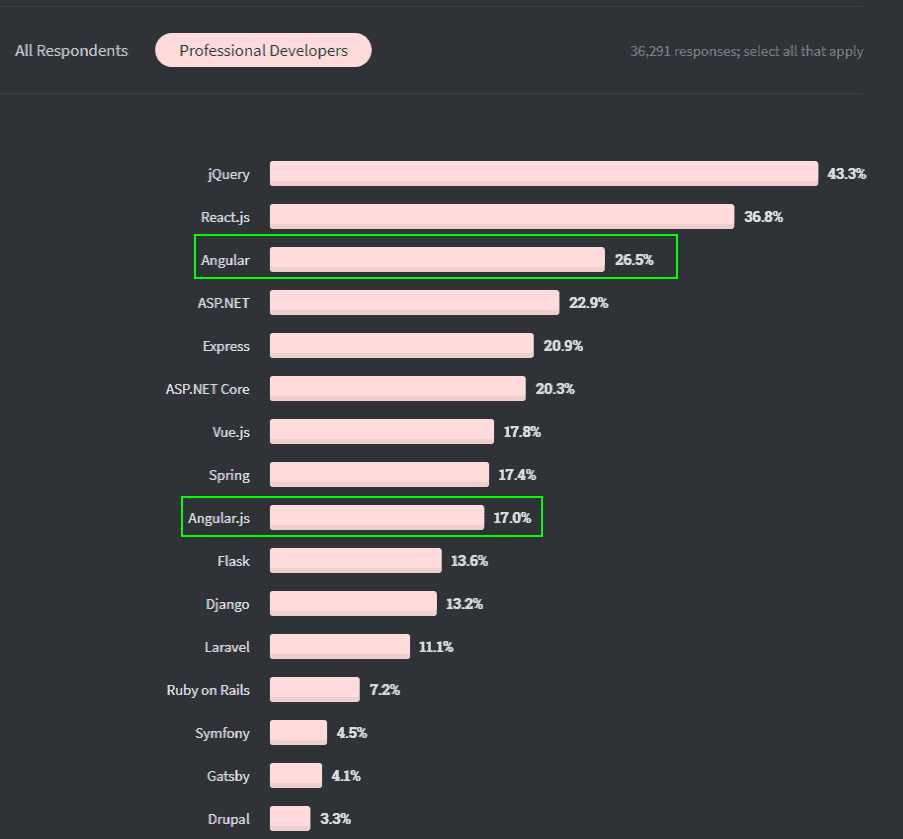Home » Angular Development » Angular vs. React: Which is Better for Your Web Apps?
Angular vs. React: Which is Better for Your Web Apps?

Angular and React are among the most popular web frameworks according to Stack Overflow Developer Survey 2020, for web-app development.

Naturally, both offer many advantages compared to other platforms. But there is always the Angular vs. React battle and many people find it hard to judge a clear winner.
However, if you have your demands with the framework for web development clearly defined, one platform might work better than the other. This is because there are areas where one platform scores better than the other. Which ones are they? That’s what we are going to talk about here.
How to decide between React and Angular?
First, we are going to introduce a general overview of both platforms. Then we are going to compare both the platforms on specific criteria like learning curve, support, architecture, etc. Then we will add up the points and see who wins the battle Angular vs. React.
One thing we need to make clear is which platform is better will always depend on your needs. Because both platforms are very popular and are being used by large businesses successfully. It all depends on what your requirements are. So let’s get to it.
Brief introduction of both platforms
React
React is a library for UI development that is based on JavaScript. It was developed by Facebook and is managed by Facebook and an open-source community of developers. React was launched in May 2013, and the latest updates of React were released in November 2019.
Who uses React?
React is used by businesses like Facebook, Instagram, WhatsApp, Airbnb, Uber, Netflix, and many others.
Angular
Angular is an open-source development framework based on typescript developed by Google. It was launched in 2016, and the latest Angular 9.0 was released in November 2019 and the Angular 10 scheduled to release in May 2020.
Who uses Angular?
Angular is used by Upwork, Google app, Nike, General Motors, HBO, Sony, and others.
Related Article: Angular: The Best JavaScript Framework For Front End Development
Which one takes more time to learn?
Learn Angular Development
- Angular is a complete and big framework and requires learning lots of tools in the early stages. Angular is based on Typescript, which is like a superset to JavaScript. Along with that, there are many concepts to learn like modules, services, components, pipes, dependency injection, and templates, that make the learning curve for Angular really steep.
- The angular framework offers multiple ways to solve a problem. Also, the framework is constantly being developed, and new features are being added which makes constant learning necessary for developers working on Angular.
Learn How to Load Dynamic HTML content in Page Using Angular
Learn React Development
- On the other hand, React is a library based on JavaScript, so if you are good at JavaScript, you have fewer things to learn compared to Angular.
- React is quite easy and minimalistic in terms of components. It has no overly complicated features. You can very quickly make an app with React.
- However, as complexity rises, you need to learn stuff like the Redux library since almost half of the React applications use the Redux library in their framework. The good thing is React provides lots of tutorials and tools for newcomers which makes the learning curve smooth and flexible.
Which one has higher performance?
React Performance
- React uses Virtual DOM(Document Object Model), which makes it much faster than Angular which uses real DOM. Virtual DOM allows updating one part of the tree without affecting the other part of the trees. Whereas in Angular, the whole tree structure is updated with a single change in one part of the tree.
- Virtual DOM is built on the server which also reduces the work of the browser. However, when it comes to speed of development, the involvement of many third-party libraries makes the process slower.
- The involvement of different libraries in different projects makes it difficult in case of a change in the developer team, as every developer prefers his own set of tools and libraries.
Performance of Angular
- Performance of Angular is lower compared to React, especially when the apps get complex. Angular uses bidirectional data-binding as opposed to unidirectional data-binding in React.
- In bi-directional binding, each data is assigned a watcher to track changes and each loop continues until all watchers and data assigned are checked to be in sync. However, newer updates and components, like the shadow API, are dealing better with this issue and performance is much better.
- Another point is that web apps based on Angular are less in size. And thanks to Angular CLI offers easy creation of workspace and swift production of application and services with simple commands owing to clean coding quality of Typescript.
App Structure
- React allows developers to choose the structure. There is no right structure for writing react apps. Since the architecture is component-based, the code can be written in two ways: function-based and class-based. The structure of Angular is fixed. The framework is based on three layers- view, controller, and model.
- An object for the model is initialized by the controller and displayed with view whereas React only offers view layer and the model and command layer is added by installing libraries. The application code is made of four components, in four separate files: a TypeScript, an HTML file, a CSS file, and a file for testing. Angular components can also be reused.
UI components
- React and Angular both have component-based architecture. The difference comes at the time of stacking.
- Angular uses Typescript, which is less prone to errors than React which uses JavaScript. Also, UI tools for React are developed by the community so there are a lot of free as well as paid tools.
- Angular has material design built-in which makes UI development faster, whereas to use material design tools in React, you’ll need to install an additional library.
Which one has better community support?
- React has the advantage of a larger developer community than Angular on GitHub and Git lab; however, on Stack Overflow, the number of Angular developers is slightly higher. Both the platforms have regular updates that often require new tools to learn and documentation tends to trail behind the update frequency.
- Especially with Angular since the updates come every six months and Google has a history of making big changes that become difficult for developers to learn, only to find something new in another 6 months. But the lack of documentation is dealt with with the help of a wide and helpful developer community.
Testing
- Angular offers I/O testing and debugging with simple tools like Karma, Jasmine, or Protractor. But in React, a set of tools are required for different stages of testing.
- In React, you need Jest for JavaScript testing, Enzyme for component testing, skin-deep for testing utilities, and so on. This may increase the hassle and slow down the testing stage.
State Management
React
In React, each component maintains its own state. A state can be held or maintained with the help of certain components. However, the global state needs to be stored in many parts of the app and data is passed through different levels of the tree.
Although, you can install the Redux library which uses a global state to represent a single stateful object. Another solution is the mobX library which stores the global state in an immutable object in the minimal required state so the rest of the state can be derived.
Angular
In Angular, data is stored in component properties where parent component passes data to child components. But in a large and complex app, it might become difficult to track the multiple branches of the tree. However, you can use RxJS or NgRx libraries for angular state management.
So far, we have compared both the frameworks on different parameters. But what do they mean for the developer, and how can you choose the right framework for designing your app.? Let’s see.
When should you use React for development?
- React is a library for UI development that can be transformed into a full developmental framework with the help of additional libraries. React appears simple and has a smoother learning curve than Angular.
- It is a better choice for your app when your team is an expert in HTML, CSS, and JavaScript development. It is a good option when your web-app has multiple varied features and components involved for specific purposes.
- In an app developed with React, you get faster development and better user experience since that is the primary purpose of React. React offers code stability with unidirectional data binding, especially when it comes to complex apps.
When should you use Angular for development?
- Angular is more complex at first and does have a steep learning curve.
- Unlike React framework, it is designed to offer full web app development as it is. It is a good choice if your development team has expertise in Java, C#, and earlier releases of Angular since learning itself will take time.
- If your app is simple to moderately complex, you can take advantage of Angular features such as cleaner code and feature-rich app in a small size. Angular also provides a material-design interface providing ready-to-use components.
Read on Angular, React Development Articles
With over 10 years of experience in Tech industry at Samarpan Infotech with architect system, problem solving and creativity. "Today is the only day. Yesterday is gone".



